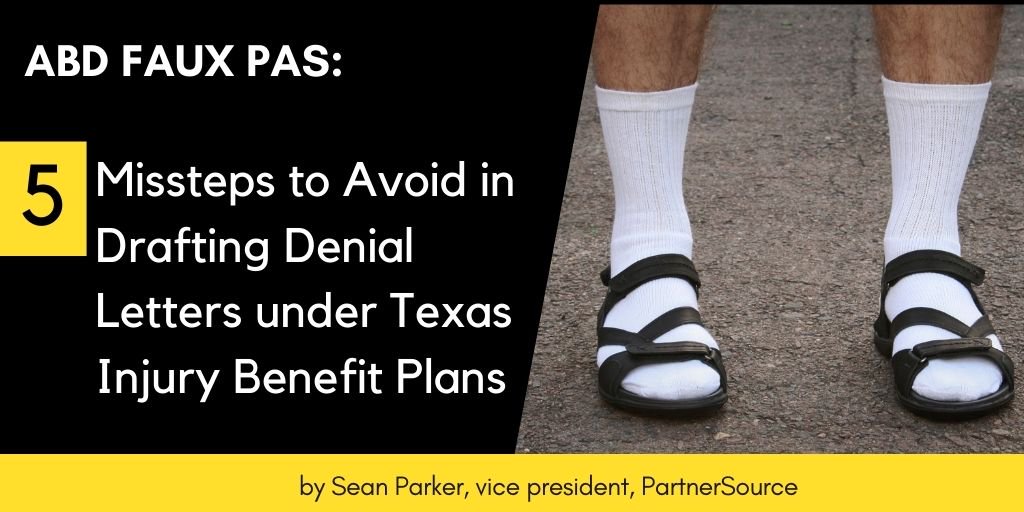
ABD: 5 Missteps to Avoid in Drafting Denial Letters under Texas Injury Benefit Plans
August 24, 2020
Sean Parker, vice president, PartnerSource
As part of PartnerSource’s claim consulting services, we see a broad mix of Adverse Benefit Determinations (ABDs) under Texas injury benefit plans. Recently, we were asked by a new client, “What are some of the common missteps you see when reviewing those letters?” There are several aspects to keep in mind when drafting denial letters under Texas injury benefit plans.
Here are the top five:
- Match the type of injury to the injury reporting timeframe. Some ABDs result when the employee’s description of how they were injured does not meet the plan’s definition of an accident – i.e., there was no specific event. However, most plans cover more than just an accident; they also cover cumulative trauma and occupational disease. Also, the amount of time an employee has to report an injury due to cumulative trauma or occupational disease is often different than an accident, so it’s important to carefully review the benefit plan and apply the correct reporting timeframe.
- Consider “good cause” exceptions. Most injury benefit plans include a good cause exception for late reporting, timing of first medical treatment, missed appointments and other compliance issues. The first step is to conduct a thorough investigation. If good cause cannot be found, the resulting ABD should not only include the plan’s good cause definition, but also clearly explain the investigation and why it was determined that there was no good cause. It should also provide guidance on how the employee can further request and support a good cause exception upon appeal of an initial benefit denial. Employers and their claim administrators should also maintain good records reflecting consideration of whether a good cause exception applies.
- Use the correct plan document: Texas injury benefit plans are updated periodically in response to ERISA/Department of Labor changes, to simplify existing plan language, to provide employees with enhanced benefits, or otherwise quickly adapt to best practices. The most recent, official plan document in effect for the date of injury is the one that determines benefit coverage.
- Disability benefit claim regulations. Speaking of Department of Labor changes, numerous regulatory updates impacted disability claims occurring on or after April 3, 2018. In part, this includes new requirements for meeting foreign language standards, increased disclosure for disability denial notices and a description of any additional information needed for the claimant to perfect the benefit claim. The changes were so numerous that it’s not uncommon to see one or more of the requirements inadvertently left out of an ABD.
- Pandemic rules for injury benefit plans. More recently, the Department of Labor issued a rule in response to the National Emergency Order for the COVID-19 pandemic. Beginning March 31, 2020, the new rule affects injury benefit plans by extending the amount of time an employee has to request initial or ongoing medical treatment and to file an appeal in response to a benefit denial. The rule temporarily limits the ability to issue an ABD for what may have previously been untimely initial or ongoing medical treatment. ABDs for any other reason must now explain to the employee the new extended timeframe for an appeal.
Have questions on an ABD? Contact Sean Parker at PartnerSource.
